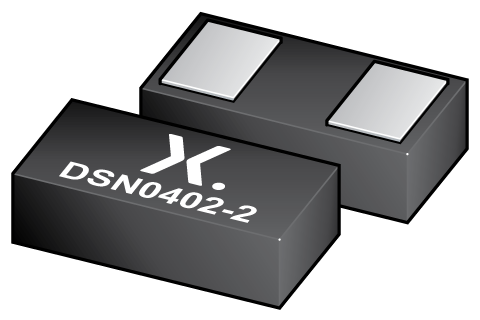
Register once, drag and drop ECAD models into your CAD tool and speed up your design.
Click here for more informationPESD5V0F1BSH
Ultra low capacitance bidirectional ESD protection diode
Ultra low capacitance bidirectional ElectroStatic Discharge (ESD) protection diode designed to protect one signal line from the damage caused by ESD and other transients. The device is housed in a leadless super small DSN0402-2 (SOD992) Surface-Mounted Device (SMD) package.
Features and benefits
- Bidirectional ESD protection of one line
- Extremely low diode capacitance Cd = 0.2 pF
- Ultra flat package: 0.12 mm high
- Ultra low leakage current: IRM < 1 nA
- IEC 61000-4-2, level 4
Applications
ESD and surge protection for:
- ultra high-speed datalines
- generic interface lines
in portable electronics, communication, consumer and computing devices.
参数类型
| 型号 | Package name |
|---|---|
| PESD5V0F1BSH | DSN0402-2 |
封装
下表中的所有产品型号均已停产 。
| 型号 | 可订购的器件编号,(订购码(12NC)) | 状态 | 标示 | 封装 | 外形图 | 回流焊/波峰焊 | 包装 |
|---|---|---|---|---|---|---|---|
| PESD5V0F1BSH | PESD5V0F1BSHYL (934068243315) |
Obsolete |

DSN0402-2 (SOD992) |
SOD992 | SOD992_315 |
文档 (6)
| 文件名称 | 标题 | 类型 | 日期 |
|---|---|---|---|
| PESD5V0F1BSH | Ultra low capacitance bidirectional ESD protection diode | Data sheet | 2017-05-09 |
| AN90063 | Questions about package outline drawings | Application note | 2025-03-12 |
| Nexperia_package_poster | Nexperia package poster | Leaflet | 2020-05-15 |
| DSN0402-2_SOD992_mk | silicon, leadless tiny package; 2 terminals; 0.25 mm pitch; 0.4 mm x 0.2 mm x 0.1 mm body | Marcom graphics | 2017-01-28 |
| SOD992 | silicon, leadless tiny package; 2 terminals; 0.25 mm pitch; 0.4 mm x 0.2 mm x 0.1 mm body | Package information | 2020-04-21 |
| PESD5V0F1BSH | PESD5V0F1BSH SPICE model | SPICE model | 2016-05-11 |
Longevity
The Nexperia Longevity Program is aimed to provide our customers information from time to time about the expected time that our products can be ordered. The NLP is reviewed and updated regularly by our Executive Management Team. View our longevity program here.
模型
| 文件名称 | 标题 | 类型 | 日期 |
|---|---|---|---|
| PESD5V0F1BSH | PESD5V0F1BSH SPICE model | SPICE model | 2016-05-11 |
How does it work?
The interactive datasheets are based on the Nexperia MOSFET precision electrothermal models. With our interactive datasheets you can simply specify your own conditions interactively. Start by changing the values of the conditions. You can do this by using the sliders in the condition fields. By dragging the sliders you will see how the MOSFET will perform at the new conditions set.